Forget dog days, in the fashion world, a new era is dawning. An era of the cat-walk – and we mean that quite literally. Step aside, runways, and make way for… the feline fashion scene. Welcome to a surprisingly expansive, often hilariously adorable, and occasionally bewildering world: cat fashion.
Is “cat fashion” just a funny internet meme, a fleeting trend born from the depths of online cat obsession? Perhaps, at first glance, it seems so. But scratch beneath the surface of tiny trench coats and miniature hats, and you'll find a world of surprisingly elaborate garments, accessories, and a trend with roots that are, perhaps unexpectedly, deeper than you might imagine. From practical sweaters designed to combat the chill to elaborate costumes crafted for social media stardom, cat clothing is a reality, a growing phenomenon, and a window into our evolving relationship with our feline companions.
Picture this: a sleek Siamese strutting in a perfectly tailored miniature trench coat, collar turned up just so. Imagine a fluffy Persian, resplendent in a hand-knitted, jewel-toned sweater. Envision a playful kitten, dashingly adorned with a sparkly, breakaway collar. Believe it or not, this isn't a scene from a cartoon – this is cat fashion in action, a tangible, if often debated, aspect of modern pet culture. This article invites you to step into this multifaceted world of feline couture. We will unravel the threads of its history, exploring its surprising origins and the diverse motivations that drive owners to dress up their feline friends. We’ll examine the dazzling array of apparel available, from functional garments to whimsical costumes, and delve into the practical purr-quisites - the crucial considerations of comfort and safety that must always be paramount. We'll navigate the ethical catwalk, exploring the ongoing debates surrounding dressing up cats, and finally, we’ll peek behind the scenes of the pop-culture phenomenon that is cat fashion, acknowledging its online virality and cultural impact. Our goal is to offer a balanced perspective, a nuanced understanding of this unique aspect of pet ownership, leaving you to ponder: is cat fashion a purr-fectly harmless bit of fun, or a step too far down the runway of anthropomorphism?
To truly understand the world of cat fashion, we need to trace its purr-fectly tailored history, unravelling the threads that have woven necessity into novelty. While the elaborate costumes and sparkly accessories might be a relatively recent phenomenon, the concept of clothing cats has roots in practicality, born from a genuine need to protect vulnerable felines. In the earliest iterations of cat clothing, function reigned supreme. Protection from the elements was the primary driver. Hairless breeds, like Sphynx cats, and cats with naturally thin coats, such as Bengals, were particularly susceptible to the cold, their lack of fur leaving them vulnerable to chills and hypothermia, especially in colder climates. For these breeds, and for elderly or sick cats with weakened immune systems or compromised thermoregulation, clothing wasn't about fashion; it was about health and well-being, providing a crucial layer of warmth and protection against harsh weather conditions, allowing them to maintain a comfortable body temperature.
Beyond cold weather protection, clothing also served a functional purpose in medical contexts. Veterinarians and cat owners alike recognized the utility of garments in post-surgical recovery. The dreaded "cone of shame," designed to prevent cats from licking and interfering with surgical sites or wounds, could be replaced or supplemented by softer, less restrictive fabric garments. These medical recovery suits, often resembling snug body stockings, provided a physical barrier against licking and scratching, promoting healing while allowing for greater mobility and comfort compared to rigid cones. Furthermore, in cases of skin conditions or wounds, protective clothing could shield sensitive areas from further irritation, dirt, and the cat’s own attempts at excessive grooming, aiding in the healing process and preventing infection. Even grooming could be assisted by specialized garments, albeit less common. For long-haired breeds prone to matting, or for cats with excessive shedding, snugly fitted garments, though not a primary solution, could theoretically offer a very minor degree of containment for loose fur or help to keep mats from worsening in specific areas, although regular and thorough grooming remained the cornerstone of coat care.
However, the narrative of cat clothing took a distinct turn, shifting from practical necessity towards fashion and decoration. This evolution mirrors the broader societal changes in pet ownership. As pets increasingly transitioned from working animals or mere companions to cherished family members, perceptions shifted. The humanization of pets became more pronounced, and with it, a growing desire to express affection, identity, and even personal style through our animal companions. This evolving pet-owner relationship paved the way for pet fashion to emerge not just as functional aid but as a form of personal expression and a unique way of bonding with our animals.
The influence of human fashion trends also began to trickle down into the pet apparel industry. Just as human fashion trends evolve and change with seasons and societal shifts, so too did pet fashion begin to mirror these trends, albeit on a miniature scale. Designers started creating pet apparel that echoed current human fashion styles, from miniature versions of popular clothing items to coordinating outfits for owners and their pets, blurring the lines between practical garments and purely decorative fashion pieces. But perhaps the most significant catalyst in the popularization of cat fashion, propelling it from niche to mainstream awareness, has been the rise of social media and visual culture. Platforms like Instagram, TikTok, and YouTube became fertile ground for showcasing cats in clothing. The inherently adorable nature of cats, combined with the novelty and often humorous aspect of seeing them dressed up, proved irresistible to online audiences. Cat fashion became visually engaging, easily shareable content, fueling trends, creating online communities, and transforming cat clothing from a fringe concept into a widely recognized, and often debated, element of modern pet culture.
But why do people dress up their cats? Beyond the historical roots, what are the underlying motivations that drive owners to adorn their feline friends in sweaters, costumes, and accessories? While the initial reaction to cat fashion might be amusement or even bewilderment, delving deeper into the motivations reveals a more nuanced picture, encompassing a spectrum of practical, emotional, social, and even humorous factors.
Practical reasons, while perhaps overshadowed by the more flamboyant aspects of cat fashion, still hold validity. As we touched upon earlier, health and comfort remain legitimate justifications for cat clothing. For vulnerable cats – those with thin coats, senior felines, or those recovering from illness – sweaters and coats still serve a vital purpose, providing necessary warmth, particularly in colder climates or during chilly indoor temperatures. Sun protection, often overlooked, is also a practical consideration, especially for light-coloured cats or those with sensitive skin. Lightweight, breathable garments can offer a degree of UV protection, particularly for cats who enjoy spending time in sunny windows or enclosed outdoor spaces, helping to prevent sunburn and reduce the risk of skin cancer. Safety, too, can be a practical motivator, though often with caveats. Reflective clothing or collars, theoretically, could increase visibility for outdoor cats, particularly in low-light conditions, making them more easily seen by cars or pedestrians. However, it’s crucial to acknowledge that for wildlife conservation purposes, allowing cats to roam outdoors, regardless of visibility aids, is generally discouraged. In specific and limited cases, allergy management might be cited as a practical reason, though its effectiveness is often debated. The idea that clothing can significantly reduce shedding and alleviate allergies is largely a misconception. While very snugly fitted garments might contain a minimal amount of loose fur temporarily, regular and thorough cleaning of the environment and the cat remains far more effective in managing cat allergies than relying on clothing.
Beyond the realm of practicality, emotional and relational motivations play a significant role in driving cat fashion trends. For many owners, dressing up their cats is simply an expression of affection and a unique way of bonding with their beloved pets. It’s a tangible manifestation of love, care, and the deep emotional connection they share. The act of choosing an outfit, carefully dressing their cat (if tolerated!), and admiring the result can be a joyful ritual, strengthening the human-animal bond and creating shared moments of amusement and connection. Fun and entertainment for owners are undeniable factors. Let’s be honest, seeing a cat in a tiny hat or a miniature costume is often inherently funny and undeniably cute. For owners, it can be a source of lighthearted entertainment, a way to inject humour and whimsy into their lives and the lives of their feline companions. While whether cats always share this amusement is debatable, some cats, particularly those with more tolerant personalities or those conditioned to accept clothing from a young age, may indeed tolerate or even seem to enjoy the attention and interaction associated with being dressed up, particularly if paired with positive reinforcement like treats and praise.
Anthropomorphism, the tendency to project human qualities and emotions onto animals, also plays a significant, if sometimes ethically complex, role in the motivations behind cat fashion. As pets become increasingly integrated into our families, they are often viewed and treated more like human family members. Dressing them up can be seen as an extension of this anthropomorphic tendency, a form of "playing dress-up" with a beloved companion, akin to dressing up a child. It stems from a desire to see our pets as reflections of ourselves, to project human aesthetics and social norms onto them, and to engage with them in ways that mirror human-to-human interactions. Social and cultural factors further amplify the allure of cat fashion. Social media, as we’ve seen, is a powerful driver, creating online trends and fostering a desire to participate in visually driven online culture. The desire to create shareable content, to garner likes and followers, and to participate in online cat communities all contribute to the appeal of cat fashion as a social media phenomenon. Humor, too, is a potent social motivator. The comedic aspect of cat fashion is widely recognized and celebrated. Dressing up cats, particularly in silly or unexpected outfits, can be seen as a lighthearted form of entertainment, a way to elicit laughter and amusement from ourselves and others, both online and offline. Finally, cat fashion can be a way for owners to connect with broader pet culture and community. Participating in cat fashion trends, sharing photos online, or even attending pet-themed events where cats are dressed up can be a way to find common ground with other pet owners, build connections, and celebrate their shared love of felines in a visually engaging and often humorous way.
The world of cat fashion, far from being a monolithic entity, encompasses a diverse spectrum of apparel, ranging from purely functional garments to whimsical costumes and elaborate accessories. Functional fashion, at its core, prioritizes practicality and utility, while still often managing to incorporate elements of style. Sweaters and coats are the quintessential examples of functional cat fashion. Designed primarily for warmth, these garments range from basic, knitted sweaters to more tailored coats with waterproof or windproof outer layers. While function is paramount, even these practical pieces often come in a variety of colours, patterns, and styles, allowing owners to choose options that are both warm and aesthetically pleasing. Raincoats and boots for cats exist, venturing into more specialized, weather-protective apparel. However, their practicality for typical domestic cats is often limited. While some breeds or individual cats might tolerate or even benefit from a raincoat in very wet conditions, the majority of cats are unlikely to readily accept or comfortably wear boots, rendering these items largely novelty items or perhaps useful in very specific, controlled situations. Medical recovery suits remain firmly within the realm of functional fashion. These garments, designed for post-surgical or wound care, prioritize healing and comfort over pure aesthetics. However, even medical suits are increasingly available in different colours and patterns, reflecting a desire to blend functionality with a touch of visual appeal, even in medical contexts.
Costumes and novelty apparel represent the more flamboyant end of the cat fashion spectrum, prioritizing visual impact and owner amusement over pure practicality. Holiday and themed costumes are a popular category, designed for specific occasions like Halloween, Christmas, birthday celebrations, or themed parties. These costumes range from simple elf hats and reindeer antlers to more elaborate full-body outfits, often intended for photos and short bursts of festive fun. Character and humorous costumes push the novelty factor further, encompassing superhero outfits, tiny chef’s hats, silly dinosaur ensembles, and a vast array of outfits designed purely for owner amusement and comedic effect. These costumes are often intentionally outlandish and designed to elicit laughter and social media shares. "Formal wear" for cats, including miniature tuxedos and dresses, represents another niche category, often intended for special occasions like pet weddings, photo shoots, or purely for the novelty of seeing a cat dressed in elegant attire.
Accessories and embellishments add the finishing touches to feline fashion ensembles, ranging from functional enhancements to purely decorative accents. Collars, moving beyond their basic function of identification tag holders, have become significant fashion accessories in their own right. Stylish collars now come adorned with charms, rhinestones, unique patterns, and a vast array of decorative elements, transforming a functional item into a fashion statement. Bandanas and scarves offer lightweight and less restrictive accessories, adding a touch of flair and colour without the full coverage of clothing. These can be easily tied around a cat’s neck and come in a wide variety of patterns and materials. Hats and headwear occupy a more novelty-driven space within cat fashion accessories. Tiny hats, from miniature top hats to silly knitted caps, and headbands, often adorned with ears or decorative elements, are primarily intended for photos and short periods of amusement. Cat tolerance levels for headwear vary greatly, and these accessories are generally best suited for cats who are particularly tolerant and for very brief photo opportunities. Jewelry for cats, while existing, requires extreme caution. Cat-safe jewelry is typically limited to breakaway collars with attached charms. Any jewelry that is not specifically designed for cats and breakaway-safe poses significant choking and entanglement hazards and should be strictly avoided. Safety must always be paramount when considering any accessory for your feline companion.
Regardless of the style or purpose of cat clothing, practical purr-quisites are non-negotiable. Prioritizing cat comfort and safety must always be the guiding principle, overriding any purely aesthetic considerations. Fit and freedom of movement are paramount. Proper sizing is absolutely crucial. Clothing that is too tight can restrict breathing, circulation, and movement, causing discomfort and potential harm. Clothing that is too loose can be cumbersome, get caught on objects, or pose tripping hazards. Accurate measurements are essential, and always consult size charts provided by clothing manufacturers, paying close attention to chest girth, neck circumference, and body length. Choose designs that allow for a full range of motion. Cats need to be able to breathe freely, walk normally, jump without restriction, and groom themselves adequately even while wearing clothing. Avoid overly restrictive designs, stiff fabrics, or garments that bind or constrict movement. Material breathability and comfort are equally important. Opt for breathable, soft, and non-irritating fabrics. Natural materials like cotton, soft fleece, and fine knits are generally good choices. Avoid itchy, scratchy, or heavy materials that can cause skin irritation or overheating.
Safety hazards must be meticulously avoided when selecting cat clothing. Clothing with small parts and embellishments poses a significant choking risk. Warn against clothing with detachable buttons, beads, ribbons, or other small decorative elements that can be easily chewed off and ingested. Elastic and tight bands should be strictly avoided. Tight elastic around leg holes, necklines, or waistbands can restrict circulation, become tangled, or cause skin irritation. Overheating is a serious concern. Cats regulate their body temperature differently than humans and can overheat easily, especially when wearing clothing, particularly in warm environments or during physical activity. Avoid overdressing cats, especially in warm weather, and monitor them closely for signs of overheating, such as panting, excessive drooling, or lethargy. Toxic materials and dyes are another potential hazard. Choose pet-safe materials and dyes. Avoid clothing made from potentially toxic materials or treated with dyes that could be harmful if chewed or ingested.
Supervision and limited duration are crucial elements of responsible cat fashion. Never, under any circumstances, leave a cat unsupervised while they are wearing clothing. Constant supervision is essential to monitor for signs of distress, discomfort, or potential hazards, such as entanglement or overheating. Limit “fashion time” to short bursts, especially when first introducing clothing to a cat. Start with very brief periods and gradually increase duration only if the cat shows tolerance and no signs of stress. Cat clothing is best suited for specific, short occasions, such as photos, brief indoor events, or medically necessary periods, rather than extended or prolonged wear. And above all, be attuned to your cat’s body language and cues. Learn to recognize the subtle signs of feline stress and discomfort. If your cat shows any indication of stress, anxiety, attempts to remove the clothing themselves, excessive panting, or any other negative reaction, remove the clothing immediately and do not force them to wear it again. Respecting your cat’s agency and prioritizing their well-being is the ethical cornerstone of responsible cat fashion, ensuring that their runway is always paved with purrs, not protests.






